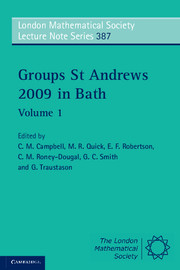Book contents
- Frontmatter
- Contents
- Introduction
- A speech in honour of John Cannon and Derek Holt
- Finite groups of Lie type and their representations
- Iterated monodromy groups
- Engel elements in groups
- Some classes of finite semigroups with kite-like egg-boxes of D-classes
- Structure of finite groups having few conjugacy class sizes
- Group theory in cryptography
- A survey of recent results in groups and orderings: word problems, embeddings and amalgamations
- A survey on the minimum genus and maximum order problems for bordered Klein surfaces
- On one-relator quotients of the modular group
- Miscellaneous results on supersolvable groups
- Automorphisms of products of finite groups
- A rational property of the irreducible characters of a finite group
- Automotives
- On n-abelian groups and their generalizations
- Computing with matrix groups over infinite fields
- Trends in infinite dimensional linear groups
- Engel conditions on orderable groups and in combinatorial problems (a survey)
- References
Finite groups of Lie type and their representations
Published online by Cambridge University Press: 05 July 2011
- Frontmatter
- Contents
- Introduction
- A speech in honour of John Cannon and Derek Holt
- Finite groups of Lie type and their representations
- Iterated monodromy groups
- Engel elements in groups
- Some classes of finite semigroups with kite-like egg-boxes of D-classes
- Structure of finite groups having few conjugacy class sizes
- Group theory in cryptography
- A survey of recent results in groups and orderings: word problems, embeddings and amalgamations
- A survey on the minimum genus and maximum order problems for bordered Klein surfaces
- On one-relator quotients of the modular group
- Miscellaneous results on supersolvable groups
- Automorphisms of products of finite groups
- A rational property of the irreducible characters of a finite group
- Automotives
- On n-abelian groups and their generalizations
- Computing with matrix groups over infinite fields
- Trends in infinite dimensional linear groups
- Engel conditions on orderable groups and in combinatorial problems (a survey)
- References
Summary
This article is a slightly expanded account of the series of four lectures I gave at the conference. It is intended as a (non-comprehensive) survey covering some important aspects of the representation theory of finite groups of Lie type, where the emphasis is put on the problem of labelling the irreducible representations and of finding their degrees. All three cases are covered, representations in characteristic zero, in defining as well as in non-defining characteristics.
The first section introduces various ways of defining groups of Lie type and some classes of important subgroups of them. The next three sections are devoted to the representation theory of these groups, each section covering one of the three cases.
The lectures were addressed at a broad audience. Thus on the one hand, I have tried to introduce even the most fundamental notions, but on the other hand, I have also tried to get right to the edge of today's knowledge in the topics discussed. As a consequence, the lectures were of a somewhat inhomogeneous level of difficulty. In this article I have omitted the most introductory material. The reader may find all background material needed from representation theory in the textbook [51] by Isaacs.
For this survey I have included a few more examples, as well as most of the references to the results presented in my talks.
- Type
- Chapter
- Information
- Groups St Andrews 2009 in Bath , pp. 1 - 40Publisher: Cambridge University PressPrint publication year: 2011

